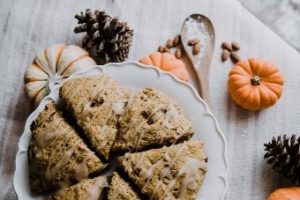As the summer comes to an end, Halloween is approaching fast and the supermarkets are stocking up on their pumpkins, ready to be picked and taken home for decoration!
In this blog, we look at the occasion from a carbon lens. In one scenario, we look at carving a medium sized pumpkin and leaving it on the doorstep, which is then followed by the waste going into a home composter. In the other scenario, we use the same pumpkin, but instead of carving it, we use it to make soup equivalent to four servings. The leftover pumpkin waste is home composted, just like our other option. In addition, we also look at a scenario where the carved pumpkin is then used to make soup instead of just fully going to composting/disposal. Similarly, we also look at pumpkin soup bought from the supermarket that is then consumed at home and the packaging is disposed off in the recycling bin. The final scenario uses the same pumpkin, which is disposed of through the residual waste bin, in this scenario waste goes to Energy from waste facilities (EfW).

As shown in the graph above, the emissions from both the activities are very similar with the home-made soup being ~20% more carbon intensive, and residual bin disposal being~30%. The use of home composting means not only transport/collection related carbon impacts are avoided but also potentially it can be used as fertiliser for your gardening/plants. Moreover, pumpkin soup bought at the supermarket has a higher carbon footprint (likely due to industrial processes involved for manufacture and packaging as well as associated transport and distribution). In choosing to make it at home instead, you may be looking at saving ~15% of carbon emitted from pumpkin soup! Significant savings are identified when the carved pumpkin is instead of disposal used to make soup at home. These models highlight the implications of our choices when it comes to holidays, customs and traditions.
If you are carving this holiday, some tips on what to do with your waste could involve the following:
- Eat it! Even If you don’t pumpkins, you will certainly find someone who does. Pumpkins are a very versatile food source that can be used in a variety of ways. Once you have finished with your pumpkin there are a number of great recipe options. You can bake it, use it in soups, risottos, pies,
 pancakes, hummus, muffins and even jams and liquors! Just make sure that there is no mould before you bake! It’s worth bearing in mind that some pumpkins are a bit more tasty than others, smaller pumpkins tend to be sweeter. Although large carving pumpkins are 100% edible, if you’re thinking about food perhaps choose a smaller pumpkin, this will also help to reduce waste.
pancakes, hummus, muffins and even jams and liquors! Just make sure that there is no mould before you bake! It’s worth bearing in mind that some pumpkins are a bit more tasty than others, smaller pumpkins tend to be sweeter. Although large carving pumpkins are 100% edible, if you’re thinking about food perhaps choose a smaller pumpkin, this will also help to reduce waste. - When preparing your pumpkin for carving, you can scoop out the pumpkin seeds and roast them to make a healthy snack or put them out for the birds to make sure that you use every part.
- You can use it as an indoor planter. If you enjoy gardening, you can start off your seeds indoors over winter. Once you have finished with your pumpkin, fill it with compost (don’t forget about the holes) and plant your seeds. Once the pumpkin starts to look a little old, plant the whole thing in the garden. The pumpkin should provide fertiliser and moisture to help seeds survive the winter.
- Create your own compost. Pumpkins are 90% water and make an excellent composting material due to the high moisture and nitrogen. It is not only important to compost your pumpkins, but also to compost other food waste. Using compost, leads to improved soil which in turn supports plant growth. This also reduces the need for fertilisers and pesticides as the home composting can be used.

- Create a bird feeder. For smaller pumpkins you can extend their life by creating a hanging birdfeeder by hanging it up outside and filling with seeds. Once it starts to decompose, you can then compost it. Pumpkins also makes a great snack for birds. If putting your pumpkin outside, be sure to avoid areas with hedgehogs! Hedgehogs will eat anything in the run up to hibernation and pumpkins can cause illness meaning that they may not survive the winter.
- You can also donate your used pumpkin to allotments, community gardens and even animal shelters and farms, particularly if they are unused, just ask locally. If donating to animals it is always ensure that there are no toxic residues on the pumpkin first e., paint, inks and candle wax etc

Credibly Green provide technical advice to clients on all things carbon. See www.crediblygreen.com or call 01746 552423 or email support@crediblygreen.com




